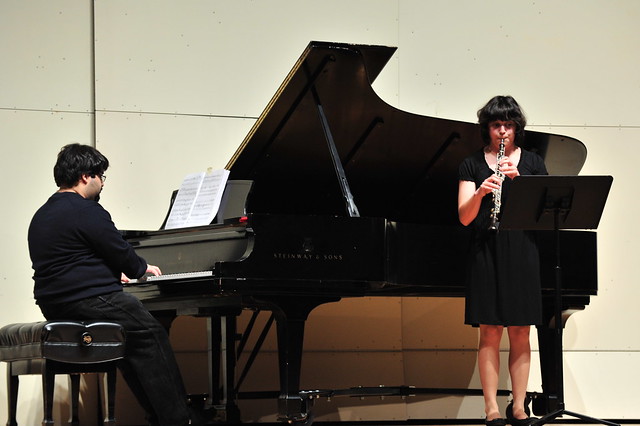Woodwinds (clarinet, oboe, bassoon, etc.) are different from piano in that they require wind (created by the player) to create a tone (using a reed or reeds to create the vibrations needed for sound). In addition to using different techniques to make the reeds vibrate in different ways, the player also changes the tone (creates the notes) by pressing and releasing (using their fingers) keys that are attached along the length of the instrument, or by covering up, then opening, various holes on the instrument.
 |
| Photo by usarmyband |
Saxophones are not considered woodwinds by some as they are made of brass. However, a saxophone is played very much in the same way as most woodwinds. Flutes and piccolos, though made of metal, are often thought of as part of the woodwind family.
As for piano, the type of wood used to make the instrument has a great effect on the quality of sound produced. Certain woods resonate better than others and thus create a better tone. In fact, many lower-priced clarinets are made of plastic and although they provide a serviceable tone, it is not the rich, "wooden" tone coveted by professionals.
Woodwinds are most often found in orchestras and smaller ensembles (although the clarinet can be found in Dixieland or jazz groups). Instruments like the English horn can be found in popular music, while the bassoon may only be found in traditional and ensemble music. There are, however, composers and musicians who explore the use of these instruments in esoteric and unconventional ways. One way to think of the woodwind family is the various instruments mimicking (representing) the human voice such as a clarinet for an alto singer, or a bassoon for a baritone singer. Many modern composer look at this group of instruments in exactly that way.
Woodwinds are tuned by adjusting their length. This is done by repositioning single components of the instrument. The musician often has to twist different sections of the instrument to make these adjustments. The longer the instrument becomes, the lower in pitch a particular note. The intonation of a woodwind is ultimately the responsibility of the player and techniques must be learned to keep the instrument in tune as it is played.
The challenge for the pianist is the fact the some woodwinds play in a different key (a Bb clarinet for example). In order for the two players to play together and communicate, both have to be aware of this and be able to transpose the two parts. For example, when the Bb clarinet plays the note Bb, that note is actually the note C on piano.
Most pianists are used to reading music in a number of different octaves and this is very important when playing with woodwinds because as a group, the cover a wide range of tones. The piano is often chosen as the accompanying instrument of a solo woodwind player or a small ensemble of woodwind instruments. One reason for this is the pianist can easily rehearse each instrument, or easily and accurately play the chords created by the ensemble.
Duane Shinn is the author of a free newsletter on piano chords & chord progressions available at "Woodwinds" Article Source: EzineArticles |

No comments:
Post a Comment